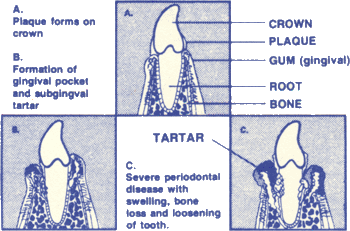PREVENTIVE dental care is just as important for your pet as it is for people, yet it is one of the most neglected health needs. While cavities do occur in both dogs and cats (more so in cats), it is periodontal or gum disease that is the most common and serious dental problem. Most pets show signs by the age of three.
Dental Tartar and Plaque build-up. PERIODONTAL disease is caused by a build-up of plaque and tartar on the teeth. This results in inflammation and infection of the gums and loosening of the teeth.
PLAQUE, a sticky, colorless, bacteria-laden film, forms continuously on the teeth. If not removed, tartar forms at the gum line. Gradually, bacteria infect the gum tissue and the root of the tooth, eroding the underlying bone that secures the teeth. Without treatment, the gums recede, forming pockets that fill with bacteria. Eventually, the teeth fall out.
TEETH and gums are very near a large network of blood vessels. With extensive build-up of plaque, tartar, and bacteria, these blood vessels pick up bacteria and carry it to other parts of the body. This accumulation of bacteria can weaken the liver, kidneys, and heart, lowering your pet’s resistance to illnesses.
WARNING SIGNS While many pets with dental disease suffer in silence, others show acute pain while eating. Some pets act depressed. In older animals, owners may mistakenly blame these signs on “old age”.
BAD BREATH and drooling are frequent signs of dental disease. Pet’s teeth are normally white and smooth. Healthy gums are pink, smooth, and tightly adhered to the teeth. Plaque and tartar occur under the gum as well as on the crown. Affected gums are thickened, reddened, and bleed easily. If any of these warning signs is present, your pet needs veterinary attention.
TREATMENT for most pets consists of having your veterinarian scale (remove) the plaque and tartar on both the surface of the teeth and below the gum line. The teeth are then polished to smooth all surfaces. Regular dental examinations by your veterinarian are needed at least once a year.
HOME CARE is the most important factor in protecting your pet’s oral health. This includes feeding a proper diet with some dry or crunchy food to stimulate the gums and reduce the build-up of plaque and tartar. Regular brushing of your pet’s teeth for the removal and/or prevention of plaque is the most important procedure. People can choose their own level of oral hygiene; pets need their owners help with this.

